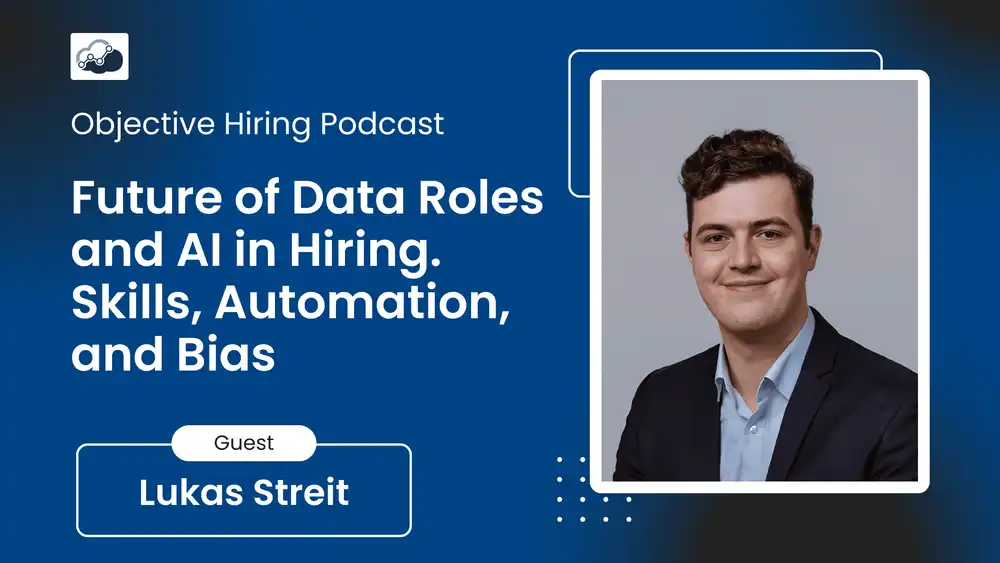How Lukas Streit Used Marketing Analytics Principles to Fix a Broken Hiring Process

On the Objective Hiring podcast, Tim Freestone, founder of Alooba, spoke with Lukas Streit, Head of Data & Analytics at DeepImmo, about how he applied performance marketing frameworks to rebuild a broken hiring process.
“We took the approach we had for customer leads… and applied it to hiring candidates.”
Lukas shares how, under intense growth pressure, his previous company treated hiring like a sales funnel—tracking every touchpoint and metric to improve recruitment outcomes. Here’s how they did it.
From Leads to Hires: Applying a Funnel Mindset
“We started measuring our application process as you would do with a lead funnel in performance marketing.”
In a business with ambitious growth targets from a private equity investor, Lukas and his team had to hire a large number of financial advisors quickly—but without sacrificing quality or cost.
They drew inspiration from their online customer acquisition strategy. Just as they optimised marketing channels based on cost per conversion, they began tracking which recruitment sources produced the best candidates.
Applications were logged and measured by source: referrals, job boards, headhunters, organic traffic, and internal recommendations. Each step—screening, interviews, offers—was monitored for conversion rates and drop-offs, just like a marketing funnel.
Real-World Data, Real Challenges
“Getting the data was quite a big one… it’s not as uniform as customer leads.”
Unlike digital leads, job candidates don’t always enter through controlled, structured channels. Some are referrals. Some come through informal conversations. Many touchpoints are undocumented.
That was one of the first obstacles Lukas faced: making the hiring process trackable. This meant standardising how applications were recorded, ensuring hiring managers updated statuses consistently, and integrating data across systems.
“It takes at least as much effort to get the business aligned on tracking… as it does to build the dashboards.”
Without clean data, analytics means nothing. Lukas had to spend just as much time driving organisational change as building the technical setup.
Cross-Functional Collaboration is Key
“We pushed the project together—data led the implementation, HR led the hiring know-how.”
Lukas describes how the success of the project came down to collaboration. HR brought domain expertise; the data team brought tracking, analysis, and system integration.
By aligning on a common goal—hiring quality people at scale—they could work together to overcome friction, including getting buy-in from frontline sales managers to log referral candidates properly.
This echoes a theme that many hiring leaders will recognise: the need for strong partnerships between data and people teams.
What Did They Learn?
“You don’t need to dive deep to start getting value. Just combining the data shows low-hanging fruit.”
One of the earliest wins was understanding the ROI of each sourcing channel. Some job boards were driving many applicants but few quality hires. Other sources, like internal referrals, had high conversion rates but weren’t being prioritised.
By seeing the funnel end-to-end, they could reallocate spend, reduce time-to-hire, and improve quality—all with better data visibility.
Why Don’t More Companies Do This?
Lukas suggests that while this approach is logical to data or marketing professionals, it’s not the norm in talent acquisition—because most people in HR or recruitment haven’t worked in structured data environments.
“It’s a funnel like any other… but most hiring teams just aren’t trained to think in this way.”
This is where hiring managers can add huge value—especially those with a background in analytics, marketing, or operations. Bringing an outsider’s perspective can unlock massive process improvements.
Scaling Requires Standardisation
“This only really works if you're hiring for the same role many times.”
Lukas is clear: this kind of structured optimisation is best suited for high-volume, low-variation roles. It’s less useful when every hire is bespoke.
That said, even in smaller-scale hiring, the principle still applies. Hiring is a process—and like any other process, it can be measured, improved, and iterated.
This is where platforms like Alooba come in. Instead of guessing who’s a good candidate based on a CV, Alooba lets you run structured assessments that benchmark real skills. It’s the same logic as A/B testing in marketing—get objective data, and optimise.
If you want to move beyond gut-feel hiring and get more scientific about who to interview, sign up to Alooba here.
Bias, Blind Spots, and Better Decisions
“The most helpful thing is getting other colleagues involved in interviews—people with different interests and perspectives.”
Even with data, Lukas stresses that human input matters. He shared how involving non-hiring team members in interviews helped challenge his own biases. These colleagues picked up on strengths and red flags he’d missed.
He also suggests experimenting with AI as a “feedback partner” post-interview—reading transcripts or notes to surface inconsistencies, bias, or scope creep in hiring discussions.
“AI could hold us to account… remind us what we were originally looking for.”
Conclusion
When hiring is treated like a marketing funnel, it unlocks entirely new levels of efficiency, clarity, and success. Lukas Streit’s case study shows how blending marketing analytics with hiring decisions leads to smarter, faster, and fairer outcomes.
For companies with the ambition to grow fast—and the discipline to track data—there’s no reason not to do the same.